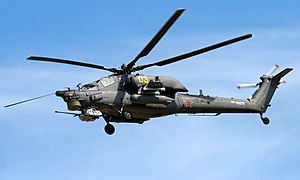Mi-28
| Mi-28 | |
|---|---|
 |
|
| Role | Attack helicopter |
| National origin | Soviet Union/Russia |
| Manufacturer | Mil |
| First flight | 10 November 1982 |
| Introduction | 15 October 2009 (Mi-28N) |
| Status | In service |
| Primary users |
Russian Air Force Algerian Air Force Kenya Air Force Iraqi Air Force |
| Produced | 1982–present |
| Number built | 126 |
| Unit cost |
US$15–16 million (2002)
|
The Mil Mi-28 (NATO reporting name "Havoc") is a Russian all-weather, day-night, military tandem, two-seat anti-armor attack helicopter. It is a dedicated attack helicopter with no intended secondary transport capability, better optimized than the Mil Mi-24 gunship for the role. It carries a single gun in an undernose barbette, plus external loads carried on pylons beneath stub wings.
In 1972, following completion of the Mil Mi-24, development began on a unique attack helicopter with transport capability. The new design had a reduced transport capability (3 troops instead of 8) and omitted the cabin, to provide better overall performance and higher top speed. Improved performance was important for its intended role fighting against tanks and enemy helicopters and covering helicopter landing operations. Initially, many different designs were considered, including an unconventional project with two main rotors, placed with engines on tips of wings (in perpendicular layout); and in one similarity with the late 1960s-era American Lockheed AH-56 Cheyenne attack helicopter design, with an additional pusher propeller on the tail. In 1977, a preliminary design was chosen, in a classic single-rotor layout. It lost its similarity to the Mi-24, and even the canopies were smaller, with flat surfaces.
Design work on the Mi-28 began under Marat Tishchenko in 1980. In 1981, a design and a mock-up were accepted. The prototype (no. 012) was first flown on 10 November 1982. The second prototype (no. 022) was completed in 1983. In 1984, the Mi-28 completed the first stage of state trials, but in October 1984 the Soviet Air Force chose the more advanced Kamov Ka-50 as the new anti-tank helicopter. The Mi-28 development was continued, but given lower priority. In December 1987 Mi-28 production in Rosvertol in Rostov on Don was approved.
An early production Mi-24 was fitted with an air data boom as an early test for the Mi-28's technologies. Later, a few Mi-24Ds were fitted up with the Mi-28's radome mount for testing the sighting-flight-navigational complex's abilities, and others had redesigned fuselages that closely resemble the future Mi-28, but with rounded cockpits.
...
Wikipedia
